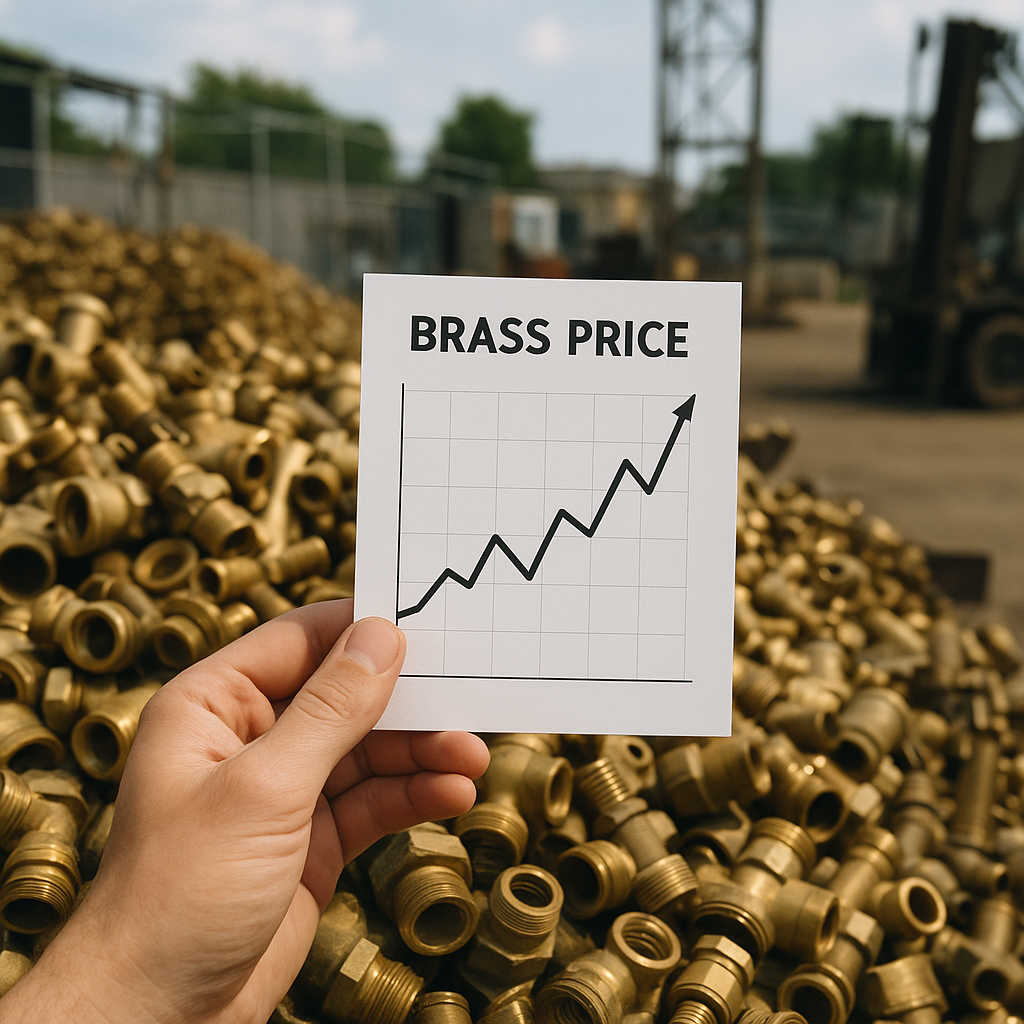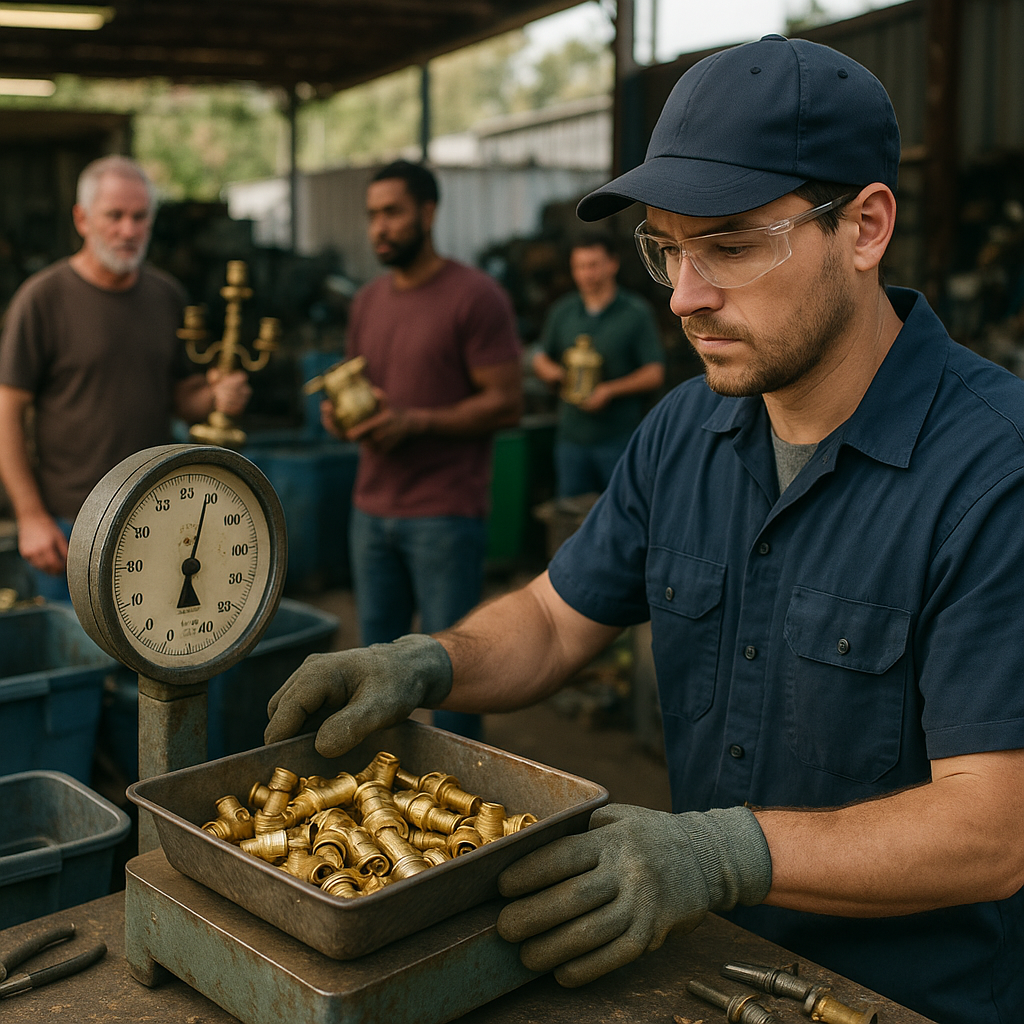5901 Botham Jean Blvd, Dallas, TX 75215
A Scrapper’s Guide to the Real Price of Yellow Brass
November 1, 2025The current price of yellow brass ranges from $1.90 to $2.62 per pound. Clean yellow brass scrap typically fetches $2.10 to $2.62 per pound, while contaminated yellow brass may sell for $1.10 to $1.90 per pound. Prices can fluctuate daily based on market conditions.
Yellow brass is an alloy composed of 60-70% copper and 30-40% zinc, with traces of other metals like tin and lead. Its distinctive golden color comes from its zinc content. The market value of yellow brass is closely tied to its copper percentage—the higher the copper content, the more valuable it becomes.
Several factors influence yellow brass prices, including global metal markets, supply chain dynamics, and manufacturing demand.
What Factors Affect Yellow Brass Prices?
Copper Content – The Primary Value Driver
The copper percentage in yellow brass significantly influences its market value. Yellow brass typically contains between 60-70% copper, with the remainder primarily being zinc. The higher the copper content, the more valuable the brass becomes. This relationship exists because copper trades at significantly higher prices than zinc on global commodity markets.
When copper prices increase on the London Metal Exchange or other trading platforms, yellow brass prices follow suit. For example, brass with 65% copper content will fetch higher prices than brass with only 60% copper. Scrap yards use specialized equipment to test the copper content when determining the value of yellow brass.
Purity and Contamination Levels
The cleanliness and purity of yellow brass directly impact its recycling value. Brass must be free of contaminants such as paint, oil, plastic, or other metals to command premium prices. Contaminated brass requires additional processing, which reduces its value at recycling centers.
Clean brass fittings, pipe sections, and decorative items typically bring higher prices than brass that needs extensive cleaning or separation. Most scrap yards pay 10-15% less for brass that contains non-brass attachments or visible contamination. Some facilities may even reject heavily contaminated brass entirely.
Market Demand and Economic Conditions
Yellow brass prices fluctuate based on industrial demand and broader economic trends. During periods of construction booms or manufacturing growth, demand for brass increases for applications in plumbing fixtures, electrical components, and decorative hardware.
Economic downturns generally lead to reduced manufacturing activity and lower brass prices. The global economic situation affects metal commodity markets broadly, with yellow brass prices responding to changes in manufacturing output, especially in industries that use brass extensively.
Regional variations also exist. Areas with concentrated manufacturing facilities that use brass may offer higher prices due to reduced transportation costs and steady demand.
Global Supply Factors
International trade policies and global supply chain issues impact yellow brass prices. Import tariffs on copper or zinc can cause price fluctuations in the brass market. When countries implement restrictions on metal imports or exports, the ripple effects can change brass values significantly.
Mining disruptions in major copper-producing nations like Chile or Peru can reduce global copper availability, driving up both copper and yellow brass prices. Similarly, zinc production issues can affect the cost structure of brass manufacturing.
| Metal Type | Copper Content (%) | Zinc Content (%) | Other Elements |
|---|---|---|---|
| Red Brass | 85-90 | 5-10 | Tin: Min 2%, Lead: Max 1%, Iron: 0.1%, Arsenic: 0.01%, Manganese: 0.5% |
| Yellow Brass | 60-80 | 30-40 | Tin: Max 1%, Lead: Max 1%, Iron: 0.1%, Arsenic: 0.01%, Manganese: 0.5% |
Regional Price Variations
Yellow brass prices can vary considerably between different regions and even between scrap yards in the same city. These variations stem from local competition, transportation costs, and proximity to brass recycling facilities or manufacturers.
Urban areas typically offer better prices than rural locations due to higher competition among scrap buyers and closer proximity to processing facilities. Price differences between neighboring facilities can sometimes reach 5-10%, making it worthwhile for sellers to compare offers from several buyers.
Seasonal factors can also influence regional pricing, with some areas seeing higher demand during construction seasons or manufacturing cycles. This creates opportunities for timing sales to maximize returns.
How Do Yellow Brass Prices Compare to Other Metals?

Yellow brass occupies a mid-level position in the scrap metal value hierarchy. It generally sells for less than copper but garners higher prices than aluminum. Current market data clearly establishes this price relationship across recycling markets.
The price difference reflects each metal’s composition and market demand. Yellow brass typically contains 60-70% copper mixed with zinc, correlating its value with its copper content, but it doesn’t match pure copper’s premium prices. Recent pricing data supports this trend.
Current price ranges show copper leading at $3.15-$4.71 per pound, with #1 copper and bare bright copper at the highest values. Yellow brass follows at $1.90-$2.62 per pound across North American markets. Aluminum trails behind with prices from $0.30-$1.42 per pound, depending on grade and purity.
Red brass, which has a higher copper content (around 85%), generally fetches higher prices than yellow brass. Recent market reports indicate red brass sells for about $3.13 per pound, roughly 20% more than yellow brass. This premium reflects its increased copper content.
Bronze, another copper-zinc alloy with additional elements like tin, also tends to command slightly better prices than yellow brass due to its enhanced properties and value in certain applications.
Within each metal category, grades significantly affect prices. Clean, well-sorted yellow brass without contaminants will always bring better prices than mixed or dirty material. For example, clean yellow brass fittings might sell near the top of the price range, while mixed brass with iron attachments could fetch 30-40% less.
Steel and stainless steel prices represent a different tier in the metal value hierarchy. Steel generally sells for much less per pound than yellow brass, while stainless steel (particularly 304 and 316 grades) can sometimes approach brass pricing depending on market conditions.
Brass prices have remained relatively stable compared to the volatile copper market. This stability makes yellow brass a reliable recycling material for steady income, even if it doesn’t reach copper’s premium values.
Where Can You Sell Yellow Brass for the Best Price?

Finding the best price for yellow brass requires effort. Market prices fluctuate regularly, recently ranging from $2.10 to $2.50 per pound at many recycling centers. This significant variation makes comparison shopping essential to maximize returns.
Start by contacting multiple scrap yards in your area. Each facility sets its own rates based on market conditions, operating costs, and business model.
The cleanliness of your brass significantly impacts the price you’ll receive. Yellow brass, which contains zinc and copper, should be free of contaminants like iron, dirt, or plastic attachments. Clean yellow brass consistently commands higher prices than contaminated material, with some recyclers paying more than double for clean versus dirty brass.
When preparing your scrap, separate yellow brass from red brass. Red brass contains a higher percentage of copper and typically fetches a premium price – about $0.50-$0.70 more per pound than yellow brass at many facilities. This simple sorting step can significantly increase your overall payout.
The type of yellow brass items you’re selling also matters. Common yellow brass scrap includes plumbing fixtures, doorknobs, valves, and decorative items. Some specialty brass items like shell casings might have their own pricing category at certain facilities.
Finally, consider convenience in your decision. A facility offering slightly lower prices but closer to you might prove more economical when factoring in transportation costs. Many recycling centers also have minimum weight requirements, so consolidating your scrap into fewer, larger loads may be more efficient.
Before loading up your vehicle, call ahead to verify current prices and any specific preparation requirements. This small effort can save you time and potentially increase your payout substantially.
Conclusion: Maximizing Value When Selling Yellow Brass

The value of yellow brass in the recycling market fluctuates based on various economic factors, with prices typically ranging from $2.00 to $2.50 per pound for clean material. Understanding these market dynamics strengthens your position when selling your scrap brass.
Keeping your brass clean, free from contaminants, separating different brass types, comparing offers from multiple recycling facilities, and staying informed about current market trends can significantly increase your returns. Remember, clean yellow brass can command prices up to $1.40 per pound higher than contaminated or dirty brass.
For professional metal recycling solutions that enhance the value of your yellow brass and other metal scrap, contact Okon Recycling at 214-717-4083.
